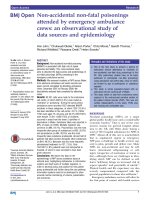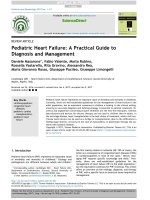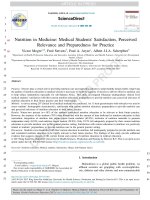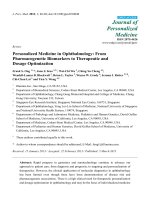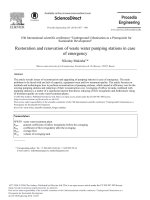Pediatric emergency medicine trisk 3687 3687
Bạn đang xem bản rút gọn của tài liệu. Xem và tải ngay bản đầy đủ của tài liệu tại đây (70.97 KB, 1 trang )
Patients with severe eye injury and pain should be triaged and evaluated
emergently.
Management
An ophthalmologist must evaluate most patients with hyphema urgently and some
emergently. Telephone consultation is warranted for low-risk patients, though
they may be followed serially in the ophthalmologist’s office as outpatients. A
low-risk patient is verbal, otherwise healthy, lacks hematologic comorbidities,
does not have other concomitant injuries, has minimal pain, has a visual acuity
better than 20/80, and has a small hyphema with layering below the pupil. For
others, emergent ophthalmic evaluation is recommended but should be tailored
based on conversation between the emergency and ophthalmology physicians.
The eye trauma itself may result in some degree of physiologic sedation. The eye
should be shielded, not patched, and the patient should be placed on couch rest to
the extent possible, and sleep with the head elevated by 30 to 45 degrees. This
position helps allow blood within the anterior chamber to settle inferiorly, thus
allowing clearance of the pupillary axis, improvement of vision, and a better view
for the ophthalmologist’s examination of the posterior segment of the globe.
Topical corticosteroids are helpful in most cases; they may help stabilize the clot
(preventing fibrinolysis) and decrease inflammation, and thus an agent such as
prednisolone acetate 1% given four times daily may be warranted at presentation
with close ophthalmology follow-up. Data supporting the use of these agents and
of oral antifibrinolytics are limited despite this approach being commonly used.
Cycloplegic eye drops such as cyclopentolate 1% or atropine 1% twice daily may
have benefit in pain control, allow improved evaluation of the posterior segment
of the eye, and may provide better drainage of the anterior chamber, although
there is not clear evidence.
TRAUMATIC IRITIS
Clinical Manifestations
Inflammation within the anterior chamber of the eye often presents 24 to 72 hours
after blunt trauma. The patient may complain of eye pain, redness, photophobia,
and visual loss. The pupil on the affected side may be constricted (see Chapter 29
Eye: Unequal Pupils ). Conjunctival injection may be confined to a ring of
redness surrounding the cornea (ciliary flush). Definitive recognition of traumatic
iritis requires slit-lamp examination. Ophthalmology consultation is
